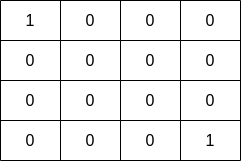| comments | difficulty | edit_url | rating | source | tags | |||||
|---|---|---|---|---|---|---|---|---|---|---|
true |
Medium |
1489 |
Biweekly Contest 103 Q3 |
|
You are given a 0-indexed 2D matrix grid of size m x n, where (r, c) represents:
- A land cell if
grid[r][c] = 0, or - A water cell containing
grid[r][c]fish, ifgrid[r][c] > 0.
A fisher can start at any water cell (r, c) and can do the following operations any number of times:
- Catch all the fish at cell
(r, c), or - Move to any adjacent water cell.
Return the maximum number of fish the fisher can catch if he chooses his starting cell optimally, or 0 if no water cell exists.
An adjacent cell of the cell (r, c), is one of the cells (r, c + 1), (r, c - 1), (r + 1, c) or (r - 1, c) if it exists.
Example 1:
Input: grid = [[0,2,1,0],[4,0,0,3],[1,0,0,4],[0,3,2,0]] Output: 7 Explanation: The fisher can start at cell(1,3)and collect 3 fish, then move to cell(2,3)and collect 4 fish.
Example 2:
Input: grid = [[1,0,0,0],[0,0,0,0],[0,0,0,0],[0,0,0,1]] Output: 1 Explanation: The fisher can start at cells (0,0) or (3,3) and collect a single fish.
Constraints:
m == grid.lengthn == grid[i].length1 <= m, n <= 100 <= grid[i][j] <= 10
According to the problem description, we only need to find the number of fish in each connected water area and then take the maximum value. Therefore, we can use the depth-first search method to solve this problem.
We define a function
We use a variable
In the main function, we traverse all the cells
The time complexity is
class Solution:
def findMaxFish(self, grid: List[List[int]]) -> int:
def dfs(i: int, j: int) -> int:
cnt = grid[i][j]
grid[i][j] = 0
for a, b in pairwise((-1, 0, 1, 0, -1)):
x, y = i + a, j + b
if 0 <= x < m and 0 <= y < n and grid[x][y]:
cnt += dfs(x, y)
return cnt
m, n = len(grid), len(grid[0])
ans = 0
for i in range(m):
for j in range(n):
if grid[i][j]:
ans = max(ans, dfs(i, j))
return ansclass Solution {
private int[][] grid;
private int m;
private int n;
public int findMaxFish(int[][] grid) {
m = grid.length;
n = grid[0].length;
this.grid = grid;
int ans = 0;
for (int i = 0; i < m; ++i) {
for (int j = 0; j < n; ++j) {
if (grid[i][j] > 0) {
ans = Math.max(ans, dfs(i, j));
}
}
}
return ans;
}
private int dfs(int i, int j) {
int cnt = grid[i][j];
grid[i][j] = 0;
int[] dirs = {-1, 0, 1, 0, -1};
for (int k = 0; k < 4; ++k) {
int x = i + dirs[k], y = j + dirs[k + 1];
if (x >= 0 && x < m && y >= 0 && y < n && grid[x][y] > 0) {
cnt += dfs(x, y);
}
}
return cnt;
}
}class Solution {
public:
int findMaxFish(vector<vector<int>>& grid) {
int m = grid.size(), n = grid[0].size();
int ans = 0;
function<int(int, int)> dfs = [&](int i, int j) -> int {
int cnt = grid[i][j];
grid[i][j] = 0;
int dirs[5] = {-1, 0, 1, 0, -1};
for (int k = 0; k < 4; ++k) {
int x = i + dirs[k], y = j + dirs[k + 1];
if (x >= 0 && x < m && y >= 0 && y < n && grid[x][y]) {
cnt += dfs(x, y);
}
}
return cnt;
};
for (int i = 0; i < m; ++i) {
for (int j = 0; j < n; ++j) {
if (grid[i][j]) {
ans = max(ans, dfs(i, j));
}
}
}
return ans;
}
};func findMaxFish(grid [][]int) (ans int) {
m, n := len(grid), len(grid[0])
dirs := [5]int{-1, 0, 1, 0, -1}
var dfs func(i, j int) int
dfs = func(i, j int) int {
cnt := grid[i][j]
grid[i][j] = 0
for k := 0; k < 4; k++ {
x, y := i+dirs[k], j+dirs[k+1]
if x >= 0 && x < m && y >= 0 && y < n && grid[x][y] > 0 {
cnt += dfs(x, y)
}
}
return cnt
}
for i := range grid {
for j := range grid[i] {
if grid[i][j] > 0 {
ans = max(ans, dfs(i, j))
}
}
}
return
}function findMaxFish(grid: number[][]): number {
const m = grid.length;
const n = grid[0].length;
const dirs = [-1, 0, 1, 0, -1];
const dfs = (i: number, j: number): number => {
let cnt = grid[i][j];
grid[i][j] = 0;
for (let k = 0; k < 4; ++k) {
const x = i + dirs[k];
const y = j + dirs[k + 1];
if (x >= 0 && x < m && y >= 0 && y < n && grid[x][y] > 0) {
cnt += dfs(x, y);
}
}
return cnt;
};
let ans = 0;
for (let i = 0; i < m; ++i) {
for (let j = 0; j < n; ++j) {
if (grid[i][j] > 0) {
ans = Math.max(ans, dfs(i, j));
}
}
}
return ans;
}
